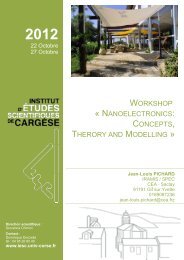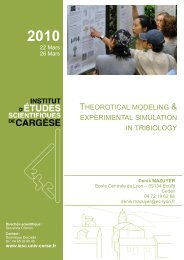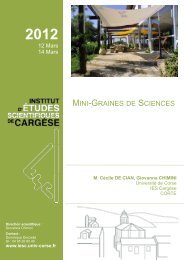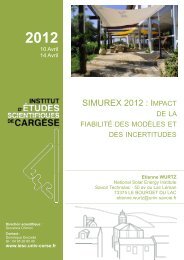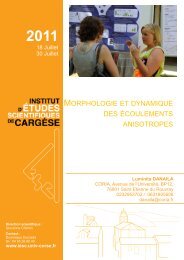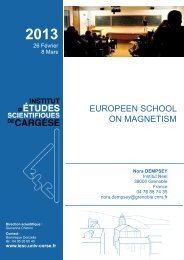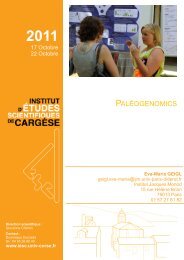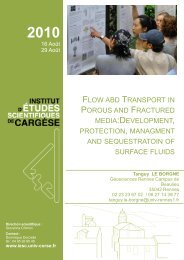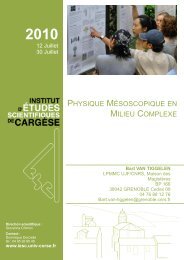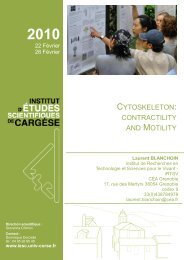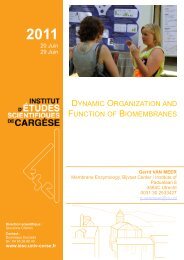Mathias FINK - Institut d'études scientifiques de Cargèse (IESC)
Mathias FINK - Institut d'études scientifiques de Cargèse (IESC)
Mathias FINK - Institut d'études scientifiques de Cargèse (IESC)
Create successful ePaper yourself
Turn your PDF publications into a flip-book with our unique Google optimized e-Paper software.
Pr. Hui Cao<br />
Light transport through random media : physics and application<br />
The first part is the fundamental study of light transport through disor<strong>de</strong>red photonic wavegui<strong>de</strong>s.<br />
We have observed position-<strong>de</strong>pen<strong>de</strong>nt diffusion by probing light propagating insi<strong>de</strong> a quasi-twodimensional<br />
random system from the third dimension. The system size and shape are <strong>de</strong>signed to<br />
enhance the interference of scattered waves so that the diffusion coefficient is modified appreciably.<br />
We also use dissipation to control the effective system size, and tune the value of diffusion<br />
coefficient via the interplay of localization and dissipation. This work <strong>de</strong>monstrates the possibility<br />
of utilizing the geometry of a random system or the dissipation to manipulate wave diffusion.<br />
The second part is the application of random media to spectrograph. We have <strong>de</strong>signed and<br />
fabricated an on-chip spectrometer based on random arrays of scatterers. The speckle patterns are<br />
recor<strong>de</strong>d and used to reconstruct the input spectra after the spectral-spatial mapping is calibrated.<br />
Multiple scattering of light increases the effective optical path length, facilitating the spectral<br />
<strong>de</strong>correlation of speckle. It allows us to dramatically reduce the <strong>de</strong>vice size without sacrificing<br />
spectral resolution. To reduce the insertion loss, we incorporate certain <strong>de</strong>gree of or<strong>de</strong>r to the<br />
random spectrometer. We have also used the speckle generated by a multimo<strong>de</strong> optical fiber to<br />
recover the input spectra. This fiber spectrometer gives high-resolution and has low-loss. A<br />
wavelength resolution of 8 pm is achieved with a 20 meter long fiber and a broadband operation<br />
covering the visible spectrum is obtained with 1.5 nm resolution using a 2cm long fiber.<br />
Pr. Georg Maret<br />
Transition to An<strong>de</strong>rson localization of light in three dimensions<br />
Georg Maret, Wolfgang Bührer, Tilo Sperling and Christof Aegerter<br />
We report experiments on the time resolved transmission of multiple scattered light in strongly<br />
turbid three dimensional media composed of high in<strong>de</strong>x (titania) nanoparticles. At small values of<br />
kl*, with wave vector k and transport mean free path l*, and at long times the total transmission is<br />
<strong>de</strong>layed [1] and the width of the intensity profile at the backsi<strong>de</strong> of the sample saturates [2]. These<br />
<strong>de</strong>viations from diffusive transport which cannot be accounted for by absorption indicate a<br />
transition to 3D An<strong>de</strong>rson localization. Data for samples with different thickness and turbidity<br />
provi<strong>de</strong> a direct <strong>de</strong>termination of their localization length as function of kl* and allow to <strong>de</strong>termine<br />
the critical value kl*c of the transition. We also discuss the spectral and power <strong>de</strong>pen<strong>de</strong>nce of the<br />
transmission which reveal the presence of nonlinear effects [3].<br />
[1] M. Störzer, P. Gross, C.M. Aegerter and G. Maret, Phys.Rev.Lett. 96, 063904 (2006).<br />
[2] T. Sperling, W. Bührer, C.M. Aegerter and G. Maret, Nature Photonics, 7, 48-52 (2013)<br />
[3] W. Bührer et.al. to be published<br />
Pr. David A.B. Miller<br />
How to <strong>de</strong>sign any linear optical component and how to avoid it ?<br />
Any linear optical structure or <strong>de</strong>vice can be readily un<strong>de</strong>rstood mathematically, but we have not<br />
known historically how to <strong>de</strong>sign any such <strong>de</strong>vice. For example, current challenging practical<br />
<strong>de</strong>vices inclu<strong>de</strong> efficient arbitrary spatial mo<strong>de</strong> splitters and converters for multimo<strong>de</strong> fiber and<br />
advanced free-space communications, especially avoiding any avoid fundamental power splitting<br />
loss. Here we show the first complete constructive method for <strong>de</strong>sign of an arbitrary linear optical<br />
<strong>de</strong>vice. In the spirit of a universal machine, this proves any linear optical <strong>de</strong>vice is possible in<br />
principle. We propose practical approaches for spatial <strong>de</strong>vices. Finally, we show how all such<br />
actual <strong>de</strong>sign work can be avoi<strong>de</strong>d completely in systems that can configure themselves without



